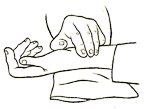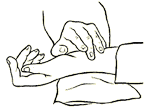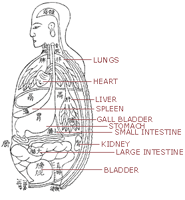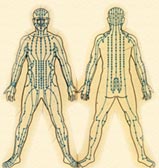IV. Palpation The palpation examination covers taking pulse and pressing the skin, hands, feet, chest, abdomen and other areas to check for pathological changes. Pulse examination is perhaps the most important aspect of the whole examination.
 Feeling the pulse Feeling the pulse
According to TCM, the pulse is the palace of blood; it is governed by the heart and commanded by qi (vital energy). Whatever the causes of the disease, abnormalities or pathological changes can be reflected by the pulse, and from this arise changes in the pulse image. Pulse-taking helps in judging the location and nature of a disease and the prosperity and decline of qi (vital energy) and pathogens to infer prognosis of the disease and form the basis for treatment.
The common location for pulse taking is above the wrist where the radial artery throbs; the first three fingers are pressed on it, which are named: the cun, guan and chi regions. (Please see picture for reference). There are various descriptions concerning the relationship between these three regions and their corresponding organs. It is generally acknowledged that the three regions of the left hand reflect respectively the conditions of the heart, liver and kidney; and those of the right hand reflect the conditions of the lung, spleen and kidney.

The different points of the pulse felt on the wrist represent the functions of different organs.
|
| When feeling the pulse, the patient places the arm at the same level with the heart. The wrist is extended and the palm faces upward. This position facilitates smooth circulation of qi (vital energy) and blood. The physician usually uses his left hand to check the right side's pulse, and the right hand to check the left side's pulse. Generally, fingers are pressed on the three regions with the same strength, and then each region is felt separately according to the actual pathological conditions. Each pulse reading should be at least 50 pulse counts. |
|
 |
 |
| Method for pulse taking |
The pulse is differentiated in terms of depth, speed, strength, shape and rhythm. Different conditions of the pulse indicate different syndromes. A normal pulse is smooth, even and forceful with the frequency of four beats per breath (approximate 60/min). However, the pulse may vary due to age, sex, and body constitution, emotional state and climatic changes. Due attention should be paid to distinguishing it from an abnormal pulse.
The common abnormal pulse signs
| Pulse type |
Characteristics |
Clinical significance |
| Floating (fu mai) |
Pulse responds to finger on light pressure but becomes weak on heavy pressure |
Exterior syndrome |
| Deep (chen mai) |
Not clear with light pressing; clear with heavy pressing |
Interior syndrome |
| Slow (chi mai) |
Rate is less than 4 beats per breath (less than 60/min) |
Cold syndrome |
| Rapid (shu mai) |
Rate is more than 5 beats per breath (more than 90/min) |
Heat syndrome |
| Deficiency (xu mai) |
Lack of force, empty and vacuous with pressure |
Deficiency in qi (vital energy) and blood |
| Excess (shi mai) |
Forceful with touching and pressing |
Excess syndrome, heat syndrome |
| Rolling (hua mai) |
Smooth and flowing like pearls rolling on a dish. |
Phlegm and fluid detention, excess heat and food retention. But it is also usual in healthy people with ample qi (vital energy) and blood, and in pregnant women. |
| Hesitant (se mai) |
Rough and uneven, opposite to rolling pulse. |
Stagnation of qi (vital energy) or blood, impairment of essence, and deficiency of blood. |
| Thready (xi mai) |
Feels like a fine thread but is very distinct and clear. |
Deficiency due to overstrain and stress or deficiency of qi (vital energy) and blood. |
| Surging (hong mai) |
Feels broad, large and forceful like powerful waves that ebb and flow. |
Excessive heat |
| Taut (xuan mai) |
Feels taut, straight and long, like the string of a violin |
Disorders of the liver and gall-bladder, painful syndromes, and phlegm and static fluid detention. |
| Tense (jin mai) |
Feels tight and forceful like a stretched rope. |
Syndromes of cold, pain and retention of food. |
| Knotted (jie mai) |
Pulse is slow and gradual with irregular or missed beats. |
Serious conditions with impairment of qi (vital energy) and blood and declining yang-qi. |
|
As the development of disease is complicated, the above abnormal pulses do not often appear in their pure form; two or more forms may be felt at the same time. For example, a floating and tense pulse indiactes exterior cold syndromes, and a floating and rapid pulse indicates exterior heat syndromes.
 Pressing examination Pressing examination
This methods enables a doctor to infer the location, nature and state of an illness by touching, feeling, pushing and pressing certain parts of the patient's body. Its content includes: pressing the skin and muscles, chest and abdomen, acu-points.
 |
| Organs in the chest and abdomen. |
Skin and muscles: Cold, feverish, moist or dry or swollen skin and muscles tell about the conditions of yang qi or pathogens that have invaded the body. In general, if pathogens are in excess, the temperature is high; when the yang qi is depleted, the temperature is low.
Chest and abdomen: Important organs reside here and symptoms of fullness, hardness, heat or pain in specific areas can indicate which organ is not functioning properly. For example, in the case of liver deficiency, the patient may experience hypochondriac pain (pain beneath the ribs), which is comforted by massage, and the area feels weak and empty when it is pressed.
 |
| Acupressure points of the human body. |
Acu-points: Chinese medicine believes that the internal mechanisms of the body are mutually connected; therefore, a given area of the body can be a reflection of the entire body. Moreover, the acu-points are places for the organs' qi to meet; abnormal sensation in these points reflects disease of the organs. For example, pressure point pain in the acu-point of "dan-shu" indicates gall-bladder disease, pressure point pain in "gan-shu" and "qi-men" indicates liver disease. |
| Front |
Back |
 |
 |
| Pressure point pain in the Qimen & Ganshu acupoints can indicate liver disease and in the Danshu point gall bladder disease. |
**Disclaimer:
All the material presented in this article is meant to serve as a guide for informational purposes only and should not take the place of a consultation from a trained TCM practitioner.
References
English:
| 1. |
Diagnostics of Traditional Chinese Medicine, edited by Zhang Enqin, Publishing House of Shanghai College of Traditional Chinese Medicine, c1990 |
| 2. |
Journal of Traditional Chinese Medicine, Lectures on Essentials of TCM VI. - Methods of Diagnosis, 2(4): 321-328, c1982 |
| 3. |
The Complete Illustrated Guide to Chinese Medicine, by Tom William, Element Books Ltd. c1996. |
| 4. |
Traditional Chinese Internal Medicine, edited by Tian Delu and Zou Jianhua, Shanghai University of Traditional Chinese Medicine c1990. |
| 5. |
Practical Diagnosis in Traditional Chinese Medicine, by Tietao Deng, Churchill Livingstone, c1999. |
Chinese:
| 1. |
中醫診斷學,北京中醫藥大學主編,學苑出版社,2002。 |
| 2. |
中醫診斷學,鄧鐵濤主編,上海科學出版社,2000。 |
| 3. |
中醫精髓圖解,湯泰元主編,科學出版社,2000。 |
| 4. |
實用中醫舌診手冊(中英文對照),李峰、宋天彬主編,科學出版社,2002。 |
| 5. |
漢英中醫辭典,歐明主編,三聯書店(香港)有限公司,1999。 |
Written By:
Raka Dewan, Integrated Chinese Medicine Holdings Ltd.
Editors:
Angela Collingwood MSN, Integrated Chinese Medicine Holdings Ltd.
Raka Dewan, Integrated Chinese Medicine Holdings Ltd.
Rose Tse, Integrated Chinese Medicine Holdings Ltd. |